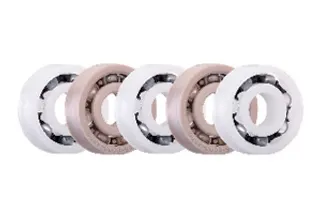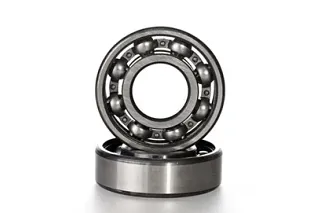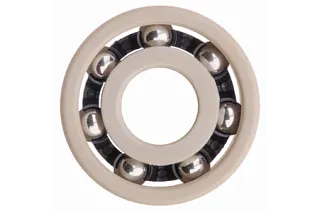Change Language :


1.1 igus® offers its line of xiros® plastic ball bearings in three different thermoplastic race materials.
Ball bearings can be used in a variety of applications, from medical and aerospace technology, to packaging equipment, electronics, office technology, and even high-end yo-yo’s.
Since these components are available in different types of materials, each with its own set of features and benefits, weighing the pros and cons of a specific kind of ball bearing can become an important part of the design process.
Three main types of ball bearings are steel, ceramic and plastic. While every ball bearing is comprised of four main parts—an outer race, an inner race, a cage and balls—each has its own set of characteristics and benefits.
Steel Ball Bearings
Partly because they are an older technology, steel ball bearings are a trusted solution for many design engineers. Typically these types of bearings are comprised of all-steel parts, but are available with different types of steel races and balls, or with a phenolic cage.

1.3 Ball bearings are available in many different types of material, such as steel, ceramic and plastic.
Ceramic Ball Bearings
The most common type of ceramic ball bearing is often considered a “hybrid”, which indicates the outer race, inner race, and cage of the bearing is comprised of steel, while the balls are made from ceramic. The ceramic material enables the bearing to run faster while maintaining a cooler operating temperature and simultaneously reducing noise and vibration.
Ceramic ball bearings tend to be more corrosion resistant, more rigid and lighter weight than most steel ball bearings. Lower coefficients and higher RPMs are also possible and, since they are nonconductive, ceramic ball bearings can be used in electrical applications. In addition, most ceramic balls bearings can operate in temperatures up to 1,800 degrees Fahrenheit.
With these advantages, ceramic ball bearings are an attractive solution. However, these types of bearings are extremely expensive, which is a strong argument in itself for seeking out an alternative solution.
Useful Links and Tools

1.2 Steel ball bearings are ideal for extremely high loads and fast RPMs, but can be noisy and require constant lubrication.
Steel ball bearings are ideal for robust applications handling extremely high loads and fast rotations per minute (RPMs) and some feature a radial load capacity of up to 30,000 pounds. Another advantage is that steel ball bearings tend to be more precise due to the clearance that can be achieved.
However, steel ball bearings do have some disadvantages. They are heavy, noisy and, depending on the grade of steel, lack chemical resistance. They require constant lubrication, which means time and cost spent on maintenance. Steel is also susceptible to corrosion in humid or wet environments. Furthermore, in medical applications, its magnetic properties can cause problems.
In addition, there is such a high number of steel ball bearing manufacturers that prices can vary greatly, ranging from inexpensive to extremely costly. This could be perceived as an advantage or disadvantage but, either way, the options can be overwhelming at times.
Plastic Ball Bearings
While plastic ball bearings are a newer technology, they have advantages that are not offered by steel or ceramic ball bearings. Plastic ball bearings are comprised of all-plastic races and a plastic cage and are typically available with a choice of three different types of balls: plastic, glass or stainless steel. The choice of material is often dependent on the environment in which the bearing will be used.

1.4 Shown above, igus®' xiros® A500 polymer ball bearing.
Plastic balls are best for applications where weight and noise are most critical, while glass balls boast less magnetic properties than 316 stainless steel balls. Glass balls are ideal when a metal-free solution is needed. Stainless steel balls are the most cost-effective choice, but do weigh more than plastic and glass. However, compared to steel balls, they still offer a significant weight advantage.
Whatever configuration, plastic ball bearings are ideal for applications with normal to high speeds and have a number of attractive features. Thanks to their plastic construction, plastic ball bearings are self-lubricating, corrosion resistant and deliver a quiet operation. Another advantage is that they are lightweight: while a ceramic ball bearing weighs about one third of its steel counterpart, a polymer ball weighs the least out of all three types.
However, there are instances where plastic ball bearings should not be used, including applications with high loads or long-term temperatures exceeding 300 degrees Fahrenheit.
Real World Comparison
Every manufacturer offers its own versions of ball bearings with varying features. A manufacturer of steel ball bearings, for example, often offers its products in a number of different types of steel, including a 300 series (soft stainless), a 400 series, or chrome steel.
